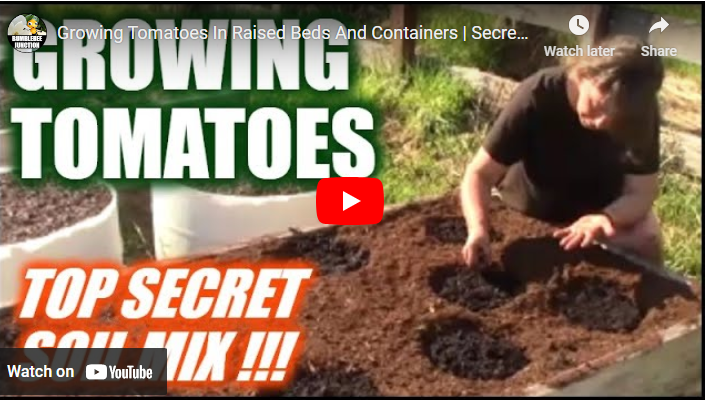Are you ready to grow luscious, juicy tomatoes in your raised beds? The key to success lies in choosing the right soil mix that provides optimal conditions for your tomato plants to thrive. In this article, we will guide you through the process of creating the best soil mix for tomatoes in raised beds. From selecting the right components to achieving the perfect balance, we’ve got you covered. Let’s dig in!
Tomatoes are notorious for being picky about their growing conditions, and the soil they are planted in plays a vital role in their overall health and productivity. A well-designed soil mix provides the necessary nutrients, drainage, and aeration required for robust tomato growth. With a properly balanced soil mix, you can set your tomatoes up for success right from the start.
Best Soil Mix for Tomatoes in Raised Beds
Before we delve into creating the best soil mix, it’s essential to understand the specific needs of tomato plants. Tomatoes require rich, well-draining soil with excellent moisture retention. They thrive in soil that is slightly acidic, typically with a pH level between 6.0 and 6.8. Moreover, tomatoes have deep root systems, so providing ample space for root development is crucial.
Components of a Well-Balanced Soil Mix
To create the best soil mix for tomatoes, you will need to combine various components that work together to provide optimal growing conditions. Here are the key components:
Garden Soil or Topsoil: Start with high-quality garden soil or topsoil as the base of your mix. Look for soil that is loamy and well-draining.
Compost: Incorporate compost into your soil mix to improve its fertility and structure. Compost enriches the soil with organic matter, essential nutrients, and beneficial microorganisms.
Peat Moss or Coconut Coir: Add peat moss or coconut coir to enhance water retention and improve soil texture. These amendments help prevent the soil from becoming too compacted while allowing for proper drainage.
Perlite or Vermiculite: Include perlite or vermiculite to promote aeration and prevent soil compaction. These additives increase the airflow within the soil, facilitating root development and nutrient uptake.
Organic Matter: Boost the nutrient content of your soil mix by incorporating organic matter such as well-rotted manure, worm castings, or composted leaves. This helps provide a steady release of nutrients for healthy tomato growth.
Step-by-Step Guide to Creating the Best Soil Mix
Now that we know the essential components, let’s walk through the process of creating the best soil mix for your tomatoes:
Step 1: Prepare the Raised Bed
Clear the area of any debris or weeds.
Ensure the raised bed is of adequate depth and dimensions to accommodate tomato plants.
Step 2: Gather the Components
Collect garden soil or topsoil, compost, peat moss or coconut coir, perlite or vermiculite, and organic matter.
Step 3: Mix the Components
In a large container or wheelbarrow, combine equal parts of garden soil or topsoil, compost, and peat moss or coconut coir.
Add a generous amount of perlite or vermiculite to the mix to improve aeration.
Incorporate organic matter, such as well-rotted manure or composted leaves, to enhance nutrient content.
Step 4: Blend Thoroughly
Use a shovel or garden fork to blend all the components thoroughly.
Aim for a uniform mixture that is well-incorporated.
Step 5: Fill the Raised Bed
Fill the raised bed with the soil mix, leaving enough space for planting the tomato seedlings.
Level the soil surface to ensure even planting conditions.
Maintaining the Soil Quality
Once you have created the best soil mix for your tomatoes, it’s crucial to maintain its quality throughout the growing season. Here are some tips to keep your soil in optimal condition:
Mulching: Apply a layer of organic mulch, such as straw or wood chips, around the tomato plants. Mulching helps conserve moisture, suppresses weeds, and regulates soil temperature.
Regular Watering: Tomatoes require consistent moisture levels to prevent issues like blossom-end rot. Water deeply and regularly, ensuring the soil remains evenly moist but not waterlogged.
Crop Rotation: Avoid planting tomatoes in the same spot every year. Practice crop rotation to minimize the risk of soilborne diseases and pests.
Companion Planting: Consider planting companion plants like basil, marigold, or borage near your tomatoes. These plants can help repel pests and attract beneficial insects.
Watering and Fertilizing Tips
Proper watering and fertilization are vital for healthy tomato plants. Here are some tips to guide you:
Watering: Water your tomatoes deeply and consistently, aiming to keep the soil evenly moist. Avoid overhead watering to prevent the foliage from getting wet, as this can lead to disease issues.
Fertilization: Provide your tomatoes with balanced organic fertilizer or tomato-specific fertilizers according to the recommended dosage. Follow the instructions on the packaging for best results.
Pest and Disease Prevention
To protect your tomato plants from common pests and diseases, follow these preventive measures:
Inspect Regularly: Monitor your plants regularly for signs of pests or diseases. Early detection allows for timely intervention.
Prune Wisely: Prune the lower leaves of the tomato plants to increase airflow and reduce the risk of fungal diseases.
Proper Spacing: Maintain adequate spacing between tomato plants to minimize the spread of diseases. Good airflow helps prevent the buildup of moisture, reducing the chances of fungal infections.
Harvesting and Enjoying Your Bountiful Tomatoes
After putting in all the hard work, it’s time to enjoy the fruits of your labor. Here’s how to know when your tomatoes are ready to harvest:
Color Change: Wait for the tomatoes to reach their mature color. Depending on the variety, this could be red, yellow, orange, or even green.
Firmness: Gently squeeze the tomato to check for firmness. It should give slightly under pressure but still retain its shape.
Easy Twisting: Mature tomatoes should come off easily when you give them a gentle twist.
Can I use regular garden soil for my raised bed tomatoes?
Regular garden soil can be heavy and may not provide adequate drainage. It’s best to create a well-balanced soil mix using garden soil or topsoil, compost, and other organic amendments.
How often should I water my tomato plants?
Tomato plants generally need 1-1.5 inches of water per week. However, the frequency may vary depending on the climate, soil type, and stage of plant growth. It’s important to monitor the moisture levels and adjust accordingly.
Can I reuse the soil mix for the next season?
It’s advisable to refresh the soil mix each season to maintain optimal fertility and minimize the risk of diseases. You can incorporate the old mix into your compost pile or use it for other non-edible plants.
Should I remove the bottom leaves of my tomato plants?
Removing the lower leaves of tomato plants improves airflow and reduces the risk of fungal infections. It’s recommended to prune the lower leaves up to the first set of branches.
What are some common pests that affect tomato plants?
Common tomato pests include aphids, whiteflies, tomato hornworms, and flea beetles. Regular monitoring and early intervention can help control these pests effectively.
By following the guidelines outlined in this article, you can create the best soil mix for tomatoes in raised beds and cultivate healthy, robust plants that yield a bountiful harvest. Happy gardening!
Conclusion
By creating the best soil mix for tomatoes in raised beds, you set the stage for healthy and productive plants. Remember to combine the right components in the proper proportions and maintain the soil quality throughout the growing season. With proper care, you can enjoy a bountiful harvest of delicious homegrown tomatoes.




